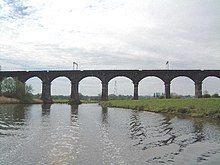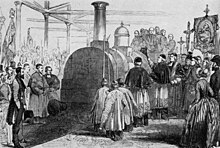Joseph Locke
Joseph Locke (born August 9, 1805 in Attercliffe ; † September 18, 1860 ) was an English civil engineer and one of the most important English railway pioneers of the 19th century. He is particularly known for his work on the Liverpool and Manchester Railway , the Grand Junction Railway and the Paris – Rouen – Le Havre line .
Youth and education
Joseph Locke was born in Attercliffe near Sheffield in Yorkshire . His family moved to nearby Barnsley when he was five years old. His father William worked there as a mining engineer. He had previously been in charge of the Wallbottle Coal Mine in Tyneside , where George Stephenson was also a firefighter. Joseph Locke left school at the age of 13 and worked as a surveyor . In 1823 he was an employee of the mine where his father worked when George and his son Robert Stephenson visited them. In 1823 George Stephenson was busy planning the Stockton and Darlington Railway . It was agreed that Joseph would volunteer for the Stephensons engineering works in Forth Street , Newcastle upon Tyne . In addition to stationary steam engines, locomotives for mine railways were also built here. Joseph Locke and Robert Stephenson became close friends. However, Robert left Great Britain for three years in 1824 in order to acquire orders for the machine works of the Stephensons in South America , especially in Peru . Joseph Locke took evening classes in mathematics and technical drawing and received recognition for his work at the factory. From 1827, George Stephenson also paid him a salary and he became one of his assistants in the construction of the Liverpool and Manchester Railway .
Railways
Liverpool and Manchester Railway
On behalf of the Liverpool and Manchester Railway , Charles Vignoles was commissioned to re-measure the planned route after an initial plan by George Stephenson in Parliament had failed. After the required law for railway construction came into being at the second attempt in 1826, construction could begin. Locke was responsible for the western section, the first 15 km, of the route , where the technically demanding facilities of the Wapping tunnel and the deep cut into Mount Olive were also built. Another topographical obstacle was the moor Chat Moss that had to be crossed. While it is considered Stephenson's accomplishment, it was likely Locke who suggested the right way to go about it.
While the railway line was being built, a decision had to be made as to whether fixed machines or steam locomotives should be used to pull trains. Robert Stephenson and Joseph Locke believed that locomotives were superior. In March 1829 they stated in a report that locomotives were able to cope with the transport task. George Stephenson demanded that the report appear under his name only, which led to a heated argument between Joseph Locke and George Stephenson. Robert Stephenson brokered the compromise that all three names were under the report.
When the line opened in 1830, seven trains ran in a convoy from Liverpool to Manchester. Joseph Locke drove the Rocket that pulled one of the trains. At Parkside station on the route, he ran over the Liverpool MP and former minister William Huskisson , who had not left the platform in time. William Huskisson died as a result of the accident . It was then recognized that Joseph Locke was not to blame for the accident.
Grand Junction Railway
In 1829, Locke was initially assigned as George Stephenson's assistant to plan the route for the Grand Junction Railway . It was to branch off the Liverpool and Manchester Railway at Newton-le-Willows and lead via Warrington to Crewe , Stafford , Wolverhampton and Birmingham , a total of 130 cm km. The directors of the new railway to be built decided in the further procedure that Locke should be responsible for the northern part and George Stephenson for the southern part of the line. In the fall of 1835 Locke became chief engineer for the entire route. This again created tension between Locke and the Stephensons. Locke was now self-employed and no longer dependent on George Stephenson. Locke's route avoided large structures as much as possible. The largest was the Dutton Viaduct over the River Weaver valley near Northwich . The viaduct consisted of 20 arches with a span of 6 meters. The line was opened on July 4, 1837. An important technical innovation were the double-headed ( dumbbell-shaped cross - section ) wrought-iron rails on wooden sleepers , which were set at a distance of 76 cm. The intent was to rotate the rails when they were worn out. This did not work because the underside of the bearings was worn unevenly, but it was still an improvement on the fish-bellied short rails that were put together between close supports and that Stephenson continued to install on the London-Birmingham Railway.
Lancaster and Carlisle Railway
An important difference between the route designs by George Stephenson and Joseph Locke was that Stephenson wanted to avoid steep inclines at all costs. Locke, on the other hand, trusted the strength of modern locomotives and their pulling power even on gradients. An example of this was the Lancaster and Carlisle Railway , which had to cross the mountains in the Lake District . In 1839, Stephenson planned a route that bypassed the Lake District entirely and passed through Morecambe Bay and West Cumberland . He thought it was the only practicable route from Liverpool to Carlisle . The Shap Fell route was out of the question for him. The directors discarded the much longer route suggested by Stephenson and chose that of Joseph Locke. Locke built the route he suggested and it worked.
The Manchester-Sheffield Railway
Locke was then commissioned to build a railway from Manchester to Sheffield , replacing Charles Vignoles as chief engineer, who had run into financial difficulties. The project included the 4.8 km long Woodhead Tunnel , which was then the longest rail tunnel in the world. The line was opened on December 23, 1845.
The following railway constructions
In the north of England Locke designed the Lancaster and Preston Junction Railway , the Glasgow, Paisley and Greenock Railway, and the Caledonian Railway from Carlisle to Glasgow and Edinburgh .
In the south he worked on the railway from London to Southampton , later called " London and South Western Railway ", where he designed, among other structures, the Richmond Railway Bridge (1848, replaced since), and the Barnes Bridge (1849), both across the Thames , the tunnel at Micheldever , also the 12-arch Quay Street viaduct and the 16-arch Cams Hill viaduct, both in Fareham (1848).
Locke was also involved in the planning and construction of several railways in other European countries, for example on the Paris – Rouen – Le Havre and Barcelona – Mattaro lines . Characteristic of his railway construction was the use of brick bridges wherever possible and the preference for inclines over tunnels.
More bridges
Locke designed or built the following bridges as chief engineer:
- Malaunay Viaduct (1844)
- Mirville Viaduct (1844)
- Bury Saint Edmunds Station Bridge (1846)
- Austreberth Bridge (1847)
Relationship with Robert Stephenson
Locke and Robert Stephenson were good friends early in their careers, but their friendship was damaged when Locke and Robert's father no longer hit it off. It seems that Robert took his father's side out of loyalty. After the death of George Stephenson in August 1848, friendship revived. When Robert Stephenson died in October 1859, Joseph Locke was pallbearer at his funeral. Locke is said to have said of Robert: " the friend of my youth, the companion of my maturity years, and a competitor in the race of life ". Locke was also on friendly terms with his engineering rival Isambard Kingdom Brunel .
In 1845 Locke and Stephenson were consulted as experts by two committees:
- In April, a parliamentary committee examined the compressed air-powered atmospheric rail system promoted by Brunel. Brunel and Vignoles were in favor and Locke and Stephenson were against.
- In August both testified before the gauge commission, which wanted to introduce a standard gauge for the whole country. Brunel advocated the seven foot gauge (2.13 m) he used on the Great Western Railway . Locke and Stephenson were in favor of the 4 foot 8½ inch (1.43 m) gauge that Georg Stephenson had introduced on the Liverpool and Manchester Railway and has been promoting ever since. Today it is considered to be the " standard gauge " worldwide .
family
Joseph Locke married Phoebe McCreery in 1834, with whom he adopted a child. Locke probably died of appendicitis in 1860 while on a hunting holiday . He, Robert Stephenson, and Isambard Kingdom Brunel all died within a period of just over a year.
The Locke Park in Barnsley was dedicated to him in 1862 by his wife Phoebe. There is a statue of him there.
Offices
Locke had been a Member of the House of Commons for Honiton in Devon since 1847 .
In 1838 he was elected to the Royal Society , in 1857 he became President of the Institution of Civil Engineers .
literature
- Derrick Beckett: Stephensons' Britain . David & Charles Limited, 1984, ISBN 0-7153-8269-1 .
- Hunter Davies: George Stephenson . Weidenfeld and Nicolson, 1975, ISBN 0-297-76934-0 .
- Joseph Devey: The Life of Joseph Locke, Civil Engineer Kessinger Publishing, 2007, ISBN 978-1-4326-7769-5 (English).
- Simon Garfield: The Last Journey of William Huskisson . Faber and Faber, 2002. ISBN 0-571-21048-1 .
- Victoria Haworth: Robert Stephenson: Engineer and Scientist . The Rocket Press, 2004, ISBN 0-9535162-1-0 .
- NE Webster: Joseph Locke: Railway Revolutionary . George Allen & Unwin Ltd., London 1970, ISBN 0-04-385055-3 .
Web links
- Joseph Locke. In: Structurae
- Joseph Locke on railscot.co.uk
- Famous Engineers on icivilengineer.com (English)
Remarks
- ↑ The construction of the line required more than 1000 unskilled workers and cost 32 lives, and 140 were seriously injured. The mortality among the workers was thus over 3 percent, while it was only 2.11 percent among the soldiers in the Battle of Waterloo . The Woodhead Tunnel was such a difficult undertaking that George Stephenson claimed it was impossible, stating that he would eat up the first locomotive to pass (Davies).
Individual evidence
- ^ Garfield, p. 132.
- ^ A b c Victoria Haworth: Robert Stephenson: Engineer and Scientist . The Rocket Press, 2004, ISBN 0-9535162-1-0 .
- ^ Garfield, p. 132.
- ^ Garfield, p. 132.
- ^ Garfield, p. 133.
- ^ A b Hunter Davies: George Stephenson . Weidenfeld and Nicolson, 1975, ISBN 0-297-76934-0 .
- ↑ a b Derrick Beckett: Stephensons' Britain . David & Charles Limited, 1984, ISBN 0-7153-8269-1 .
- ^ NE Webster: Joseph Locke: Railway Revolutionary . George Allen & Unwin Ltd., London 1970, ISBN 0-04-385055-3 .
- ↑ Barnsley and Family ( Memento of the original from August 1, 2010 in the Internet Archive ) Info: The archive link was inserted automatically and has not yet been checked. Please check the original and archive link according to the instructions and then remove this notice.
| personal data | |
|---|---|
| SURNAME | Locke, Joseph |
| BRIEF DESCRIPTION | English civil engineer |
| DATE OF BIRTH | August 9, 1805 |
| PLACE OF BIRTH | Attercliffe |
| DATE OF DEATH | September 18, 1860 |






